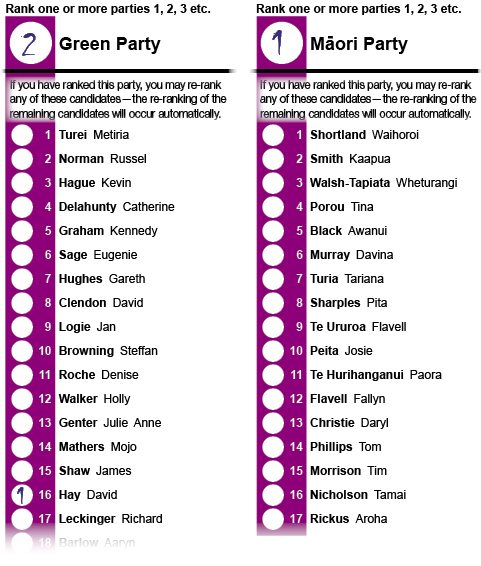Ranking not ticking to tame party lists

Wrangling the Rankings: There is no possible justification for not allowing voters, should they so wish, to participate in the ranking of candidates, the default order having first been determined by the party. Note that only the party preference that took effect—in the case of this mock-up, not that for the Māori Party, given that it failed to reach the 5% threshold—would carry with it any re-ranking by the voter. Party ballot mock-up Mahurangi Magazine
It’s a graphic illustration of the limitations of an electoral system. Despite every poll screaming its opposition to asset sales, the National Party ploughs ahead claiming that last year’s win over Labour provides it with an unassailable mandate to implement its ideology.
Aotearoa has had fewer than 16 years of mixed member proportional government, and it shows. The winner-takes-all, first-past-the-post attitude still prevails in the thinking of the major parties. With 120 192 more people voting in 2011 for other parties, than for National, the party nevertheless believes that it alone enjoys the authority to direct, even dictate, policy. Had New Zealanders put more distance between two-party thinking and coalition government, they would surely demand that policy-making was the responsibility of Parliament, and would not condone the perversion of democracy that sees the second highest polling party, Labour, arbitrarily sidelined.
The current review of mixed member proportional focuses on some of the perennial irritants, ‘the issues the Commission must review’, but in addition…
other aspects of the MMP voting system can be considered as long as they relate directly to the way MMP works.
Squarely in this category is that vestige of first-past-the-post whereby electorate candidates are still chosen by the winner-takes-all method. At least four seats taken by National in the last election would have been won easily by Labour, had voters’ second preferences been taken into account. In each of these instances it was the second preferences of most Green Party supporters that would have swung the seat to Labour. Elsewhere the Green Party might have picked up an electorate seat or two, with the second preferences of Labour Party supporters.
The right to elect a local representative is a cornerstone of democracy, so there can be no justification for the local member being other than the person most people in that electorate prefer. With preferential voting, rather than ‘spoiling’ the result in many marginal electorates, and the Green Party would win some of them, provided that it gave itself a fighting chance by standing the occasional charismatic candidate.
Ranking, rather than ticking is the solution to another aspect of the mixed member proportional system that is patently undemocratic. Included in the list of seven specific aspects that will be reviewed is:
A party’s ability to determine the order of candidates on its party list and the inability of voters to rank list candidates in order of preference
The solution is ridiculously simple. Voters need only to be given the option of over-riding the party list of their preferred party. And when choosing to promote or demote a list candidate, the voter would not be required to laboriously reorder an entire list, just the candidate, or candidates, of concern—the others would reorder automatically.
Rather than tick a single party, voters would have the choice of ranking two or more. That way, if they were amongst the nearly 150 000 who in 2011 voted for parties that failed to reach the 5% threshold, the chances are their second or subsequent preference would have gone to a party that was represented.
Fewer votes would be wasted, of course, if the threshold was lowered from 5% or removed—mind it takes about 0.83% of the vote to elect each member, so no threshold equals a 0.83% threshold. A more precautionary option would be to implement Stephen Todd’s graduated threshold, whereby at say 3% a party is entitle to one representative, through to full representation at 5%. As the person pivotal in the world’s first computer implementation of single transferable voting using the Meek method, Stephen Todd deserves an attentive hearing.
To qualify to appear before the Electoral Commission, a person or entity must lodge a written submission by midnight this Thursday. To date more than 2000 have been submitted, and may be read online. The Mahurangi Magazine is choosing to be heard, but through no love of hearings. Having published more than its share of articles on electoral reform over the last four and a half years—twenty on mixed member proportional alone—the review represents something of a last roll of the dice. Aotearoa can either forge ahead and further the cause of democracy or clip its wings with appeasements to those who believe anyone who doesn’t already have their feet under the table should be denied even the crumbs.
The Electoral Commission is doing a decently diligent job of facilitating feedback, including by providing an online five-minute submission form. Whether using this quick form—which unsurprisingly excludes the option of being heard—or the more detailed online form, or submitting a document online or by mail, the final date for lodging submissions is 31 May.
Here’s hoping the commission shows something of the courage of the 1986 royal commissioners who rejected half measures and recommended the most fully proportional system yet devised, and go one better by adding in the missing component…
…preferential voting.
Footnote for the Machiavellian Of course, only those party re-rankings that accompany preferences actually utilised would be given effect, otherwise voters could sabotage the lists of parties other than those they support.
